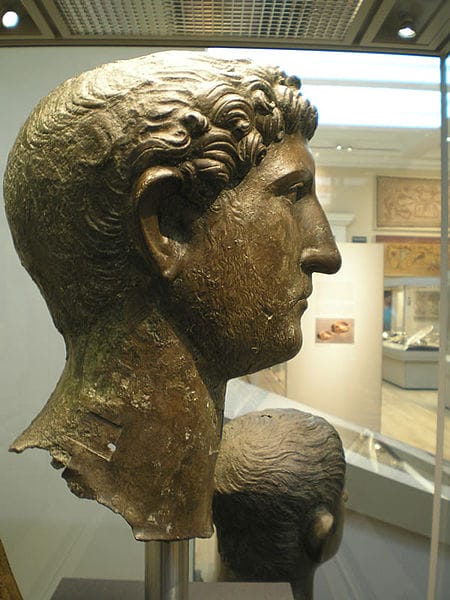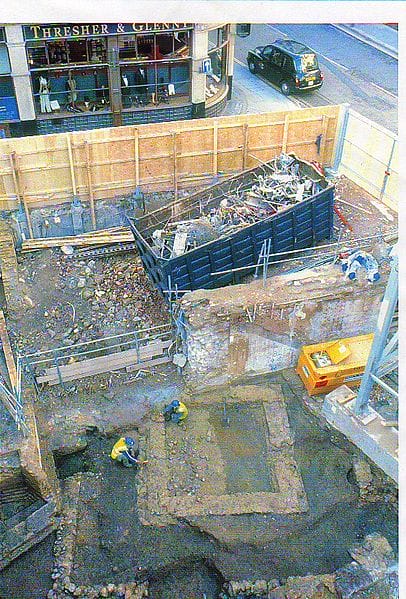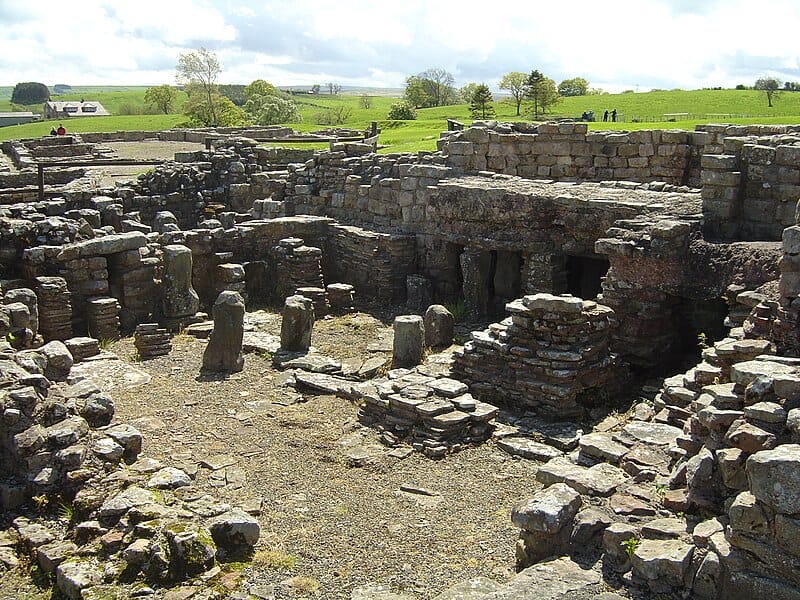Archaeologists have recently unearthed a Roman funerary bed in central London, shedding new light on the ancient burial practices of the city. The bed, which dates back to the 2nd century AD, was discovered during excavation work for a new development in the Southwark area. The find has been described as “exceptional” by experts, who say it is the only known example of its kind in Britain.
The funerary bed is made of stone and is decorated with intricate carvings of mythical creatures, including griffins and sirens. It was found in a tomb alongside the remains of a wealthy Roman woman, who was buried with a range of luxury items, including jewelry, pottery, and glassware. The discovery of the bed is significant because it provides a rare glimpse into the funerary practices of the Roman elite in London and suggests that they were willing to invest in elaborate and expensive burial arrangements.
Discovery of the Roman Funerary Bed
In central London, a Roman funerary bed was recently discovered during an archaeological excavation. The site is located near the River Thames, in an area that was once a Roman settlement. The bed was found in a tomb that was part of a larger cemetery. This discovery was made during a routine excavation by a team of archaeologists. The bed was found in a tomb that was carefully constructed and decorated with intricate carvings. The tomb was likely built for a wealthy Roman citizen.
The excavation of the tomb and the funerary bed was a delicate process. The bed was made of stone and was extremely heavy, so it had to be carefully removed from the tomb and transported to a laboratory for further study. The archaeologists used a variety of tools and techniques to excavate the tomb and the bed, including brushes, trowels, and shovels.
The discovery is significant because it provides valuable insight into the burial practices of the ancient Romans. The bed is believed to date back to the 2nd century AD, and it is one of the best-preserved examples of a Roman funerary bed ever discovered in the UK. The bed will be studied further to learn more about its construction, decoration, and the person who was buried in it.
Historical Significance
The bed was made of stone and was designed to hold the body of the deceased, with a small recess for the head. Roman funerary practices were highly ritualized and varied depending on social status and location. Wealthy Romans were often buried in elaborate tombs with intricate carvings, while the poor were buried in simple graves. The discovery of the funerary bed suggests that the individual buried in the tomb was of high social status.

The discovery also provides insight into the cultural context of the city during the Roman occupation. London was an important Roman settlement known as Londinium and was a hub for trade and commerce. The city was home to a diverse population, including Romans, Britons, and other ethnic groups.
The discovery of the funerary bed suggests that the Roman population in London had access to the latest burial practices and technologies. The stone bed was likely an expensive and prestigious item reserved for the wealthiest members of society. The tomb also contained other artifacts, including pottery and jewelry, which provided further evidence of the material culture of the time.
Analysis of the Artifact
The Roman funerary bed found in central London is made of limestone, a sedimentary rock composed mainly of calcium carbonate. Limestone was a common building material in ancient Rome, and it was often used for funerary monuments and sarcophagi. The limestone used in the construction of the bed is of high quality, with a fine-grained texture and a uniform beige color. The limestone is also relatively soft and easy to carve, allowing for intricate decorative details to be added to the bed.
Despite being over 1800 years old, the bed is remarkably well-preserved. The limestone has weathered over time, giving it a slightly rough texture, but the decorative details are still clearly visible. The bed is also structurally sound, with no major cracks or damage to the stone.

The excellent preservation of the funerary bed can be attributed to several factors. First, the bed was buried underground for centuries, which protected it from exposure to the elements. Second, the limestone used in its construction is relatively resistant to weathering, especially compared to other types of stone. Finally, the bed was likely stored in a dry, cool environment after it was excavated, which helped to prevent further deterioration.
Implications for Future Research
This discovery opens up new avenues for comparative studies with similar artifacts found in other parts of the Roman Empire. By examining the design and construction of the bed, researchers can gain insights into the cultural practices and beliefs surrounding death and burial in Roman society. Comparing the features of the bed with those found in other Roman funerary beds can shed light on regional variations and similarities in Roman burial practices.
The bed was discovered during routine excavation work at a construction site, indicating the potential for more significant discoveries in unexpected places. This underscores the importance of thorough archaeological surveys before any construction work is undertaken to ensure that valuable historical artifacts are not lost.

Furthermore, the use of modern technologies such as 3D scanning and computer modeling can enhance the accuracy and efficiency of archaeological excavations. By creating digital models of the artifacts and the excavation site, researchers can gain a better understanding of the context and relationships between different objects. This can lead to more accurate reconstructions of historical events and cultural practices.
Public Exhibition and Education
The Roman funerary bed found in central London is displayed in a public exhibition at the British Museum. The bed, which dates back to the 2nd century AD, is showcased alongside other Roman artifacts and is given a prominent position in the museum’s Roman Britain gallery. The display plans for the bed include a custom-made glass case that will allow visitors to see the bed from all angles while protecting it from damage. The case is also equipped with lighting that highlights the intricate carvings and details of the bed.
In addition to the public exhibition, the British Museum has planned a series of educational outreach programs to accompany the display of the Roman funerary bed. These programs are designed to engage visitors of all ages and backgrounds and will include guided tours, lectures, and interactive activities. The museum’s education team has also developed a set of teaching resources for use in schools and universities. These resources include lesson plans, activity sheets, and background information on the Roman period in Britain.
People Also Ask:
What significance does the Roman funerary bed hold in historical context?
The Roman funerary bed found in central London holds great significance in historical context as it sheds light on the burial practices of the Roman Empire. It is believed that the bed was used to carry the deceased to their final resting place, and the fact that it was found in London suggests that the city was an important center of Roman activity.
How does the Roman funerary bed discovery contribute to our understanding of Roman burial practices?
The discovery of the Roman funerary bed in London contributes greatly to our understanding of Roman burial practices. It provides evidence of the use of elaborate and ornate furnishings in funerals and suggests that the Romans placed great importance on the treatment of the dead. The bed also offers insight into the social and economic status of the deceased, as only the wealthy would have been able to afford such a lavish burial.
What techniques were used to uncover and preserve the Roman funerary bed in London?
Archaeologists used a variety of techniques to uncover and preserve the Roman funerary bed in London. The bed was carefully excavated using hand tools to avoid damaging the delicate structure. Once it was removed from the ground, it was transported to a laboratory where it underwent a process of conservation to prevent deterioration. The bed is now on display in a museum where it is carefully monitored to ensure its preservation.
Can the public view the Roman funerary bed found in London, and if so, where?
Yes, the public can view the Roman funerary bed found in London. It is currently on display at the Museum of London, where visitors can see it up close and learn more about its history and significance.
What other artifacts were found alongside the Roman funerary bed?
Several other artifacts were found alongside the Roman funerary bed, including pottery, jewelry, and coins. These objects provide further insight into the burial practices and daily life of the Romans in London.
How will the Roman funerary bed discovery impact future archaeological research in central London?
The discovery of the Roman funerary bed in London will undoubtedly have a significant impact on future archaeological research in the area. It highlights the importance of continued excavation and preservation efforts and provides a valuable resource for researchers studying the history and culture of the Roman Empire.
Hello, my name is Vladimir, and I am a part of the Roman-empire writing team.
I am a historian, and history is an integral part of my life.
To be honest, while I was in school, I didn’t like history so how did I end up studying it? Well, for that, I have to thank history-based strategy PC games. Thank you so much, Europa Universalis IV, and thank you, Medieval Total War.
Since games made me fall in love with history, I completed bachelor studies at Filozofski Fakultet Niš, a part of the University of Niš. My bachelor’s thesis was about Julis Caesar. Soon, I completed my master’s studies at the same university.
For years now, I have been working as a teacher in a local elementary school, but my passion for writing isn’t fulfilled, so I decided to pursue that ambition online. There were a few gigs, but most of them were not history-related.
Then I stumbled upon roman-empire.com, and now I am a part of something bigger. No, I am not a part of the ancient Roman Empire but of a creative writing team where I have the freedom to write about whatever I want. Yes, even about Star Wars. Stay tuned for that.
Anyway, I am better at writing about Rome than writing about me. But if you would like to contact me for any reason, you can do it at [email protected]. Except for negative reviews, of course. 😀
Kind regards,
Vladimir
